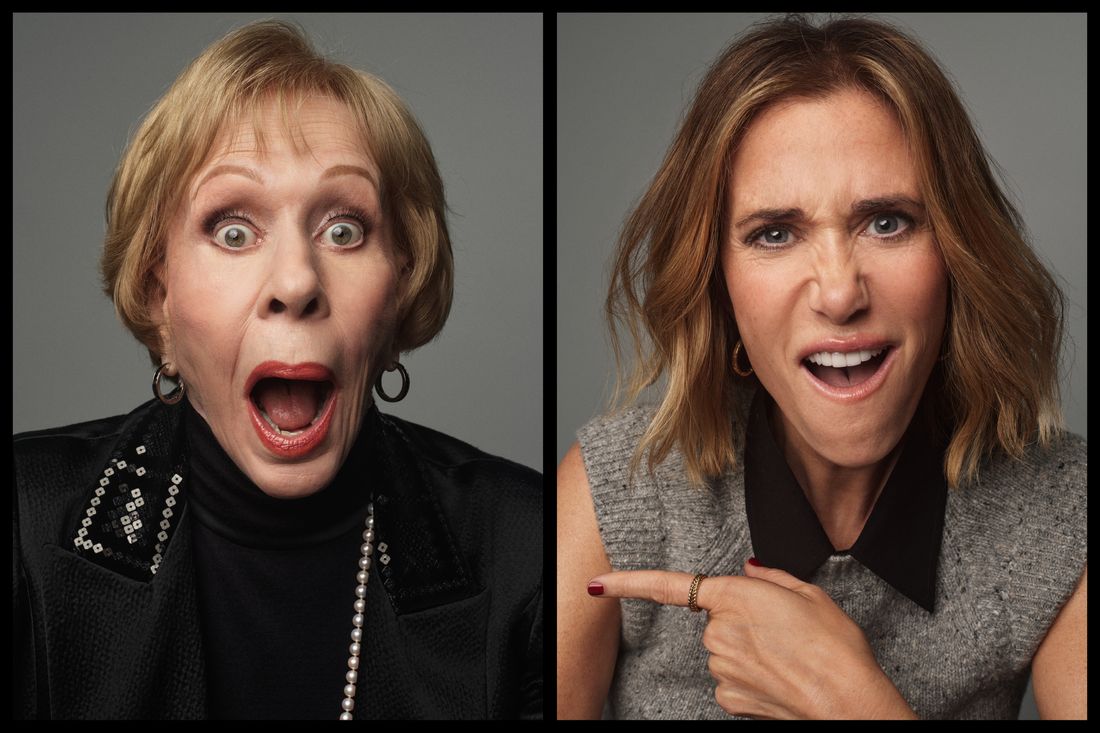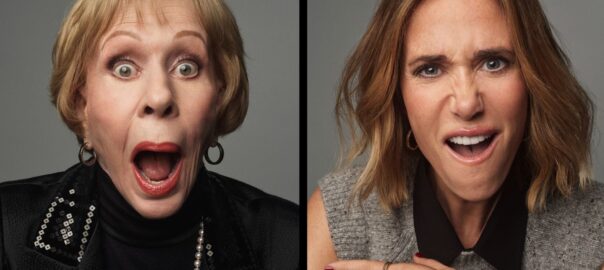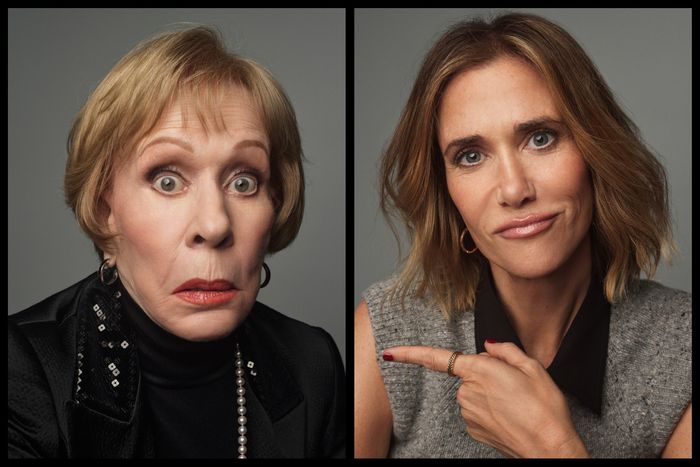[ad_1]

Photo: Mark Seliger for New York Magazine
As a social-climbing hustler trying to gain access to an exclusive country club, Kristen Wiig plays Palm Royale’s Maxine like a steamroller. Spouting torrents of nonsense in a Tennessee accent, she hides her ever-present terror of being exposed behind sunglasses and an enormous smile. It’s the sort of character Carol Burnett, who plays Maxine’s comatose aunt Norma, might’ve embodied on her classic CBS variety series The Carol Burnett Show — one of the many eccentrics and neurotics who would influence Wiig’s run on Saturday Night Live nearly four decades later.
In the Apple TV+ series, Burnett’s ability to unleash an electric performance charges the screen, even when playing mute and immobile, and watching the pair perform together makes you wonder why they weren’t united sooner. Both throw themselves into their characters with a laser-focused intensity that’s funny in part because it’s so unnerving. Acting opposite Burnett never struck Wiig, who used to watch The Carol Burnett Show in reruns as a child, as a possibility, though she credits the series with inspiring her to audition for The Groundlings, and thus, a career in sketch comedy. “It had a huge impact on me,” Wiig says, sitting opposite Burnett on the patio of the Four Seasons Hotel restaurant in Los Angeles. “Not even just the work and the characters, which I fell in love with, but to have your own show as a woman was unheard of. She’s unlike anybody in the history of comedy.”
Carol, I used to watch your variety show with my mother and grandmother, and they used to nearly asphyxiate from laughter at the sketches, particularly the ones where Tim Conway played Mr. Tudball and you were his secretary, Mrs. Wiggins.
Carol Burnett: Tim wrote those characters. Originally, he wrote Mrs. Wiggins to be this doting old lady. I went into the costume fitting that way, and Bob Mackie, a genius, said, “We’ve been doing a lot of old ladies lately. Let’s make her into this bimbo with a push-up rump, somebody the IQ fairy never visited.” Bob put me in this funny little blouse and added this old black skirt that was kind of bald and tight at the knees and baggy in the behind, plus stiletto heels.
I said, “Bob, I’m flat back there. You’re going to have to take that in.” And he said, “No — stick your butt into it.” And that gave me Mrs. Wiggins’s walk. It was the only way I could walk because the skirt was tied at the knees!
What was the writing process on your show? How much time did you have to do an episode?
CB: Say I wanted to do Mildred Pierce, because I remembered seeing all these movies with my grandmother and loving them. I’d go to the writer, they would write the sketch, and we’d do it three weeks later. I would help write because I remembered the movie. Lots of times when we’d be rehearsing with Harvey and Vicki or Lyle and we had a line we wanted to change, I’d call the writers to come down. And they just said, “Listen, if you can make it funnier, do it.” Nobody was like, “No, you can’t change my line!”
Kristen, does this remind you of SNL?
KW: When you said three weeks, I was like, “That’s so long!” At SNL, you write it on a Tuesday night, you read it on Wednesday, and the rewrite happens Thursday.
CB: Well, three weeks when I would suggest something. Tim didn’t take three weeks. He just had the idea, wrote it, and we read it and did it.
KW: Sometimes I would go to a writer and say, “I have a character.” Sometimes a writer would come to me. Most of the time, you make an appointment with a writer and you hang out in their office. You don’t have an idea, and an hour later you’re laughing about something like, “Let’s write that.” Your brain is always trying to think of new characters. You’re watching people on the subway, trying to get ideas. It’s a nonstop machine.
Kristen, how do you work out a character physically?
KW: Sometimes it’s a voice. Sometimes it’s the way you stand. Sometimes it’s a catchphrase or even a look. There was a character I did just a couple of times, a woman at a party that kept saying, “Don’t make me sing!” James Anderson and I wrote most of my stuff together. That character started out being hunched over. The body language came first, then we just kept saying, “Don’t make me sing.”
Carol, how did you get a producer credit in the ’60s, when there were no major women TV producers except Lucy?
CB: I signed a contract with CBS when I was on The Garry Moore Show requiring me to do one special a year plus two guest shots. Within the first five years, my agent got me a deal where if I wanted to do an hour-long comedy variety series, all I had to do was push the button and CBS would have to put it on for 31 hours, whether they wanted to or not.
KW: Did they think that’s what you wanted at the time?
CB: No. I wanted to be on Broadway. Then the fifth year rolled around, the last week between Christmas and New Year’s, and my husband and I just moved from New York to California. We put a down payment on a house. I already had one baby. And we looked at the contract and said, “Maybe we should push that button.”
Did either of you reach a point with a popular character where you’re like, This is starting to run my life. I don’t want to do this character anymore?
KW: They have a shelf life, for sure. I feel it more the minute after I do it for the last time, like, I think that was it, she’s going to retire.
CB: There was one character I stopped doing after a while. Zelda was an awful wife of Harvey’s. He would have these fantasies that he could kill her, but then she would show up in his fantasies. Sometimes he was a toreador and I was the bull. After a while, she was so annoying, I said, “She makes me angry. I don’t want to do her anymore.”
Does drama exercise different acting muscles from sketch comedy?
KW: There’s something to creating characters that have a little bit of — I don’t want to say sadness, but a yearning, I guess. Not to sound too deep about it, because you are trying to make people laugh, but to have the drama makes the comedy more funny, and vice versa. You need to find that weird balance.
CB: That’s what I love. When we did the family — Eunice and Mama and Ed — that could get pretty heavy. They originally wrote it for me to be Mama and we were going to have a guest star play the daughter, Eunice. But Eunice spoke to me because my mother wanted her dreams and they never happened. She was always angry, but underneath, pitiful. So I said, I want to play Eunice. We were going to hire an older actress to do Mama. We only thought we were going to do this one time, and because we couldn’t think of who to get, Bob Banner said, “I’ll put Vicky in a wig and a fat suit and take off her eyelashes” She was 24 years old, but she became Mama and it grew from there. She was fabulous.
I loved those sketches because there wasn’t a joke in them. It was all character-driven. One of the really heavy ones was when Eunice got to perform on The Gong Show. It was very funny up until she was gonged, and you see the camera on her face [Burnett frames her face with her hands, with a stricken expression] and then they did a freeze-frame and she got smaller and smaller in the frame until she disappeared. Eunice thought she was going to be a movie star. When the sketch ended, people cried.
Kristen, what’s your favorite Carol Burnett Show sketch?
KW: I do love Mrs. Wiggins. I love when you did the movie parodies.
CB: The one everyone talks about the most is Gone With the Wind. “Went With the Wind,” we called it. That was about 25 minutes long.
KW: What? Does that exist somewhere, the 25-minute version?
You never got to that length at Saturday Night Live, did you?
KW: No, it was three or four minutes. Five minutes would have been a long time.
CB: One of the writers was a guy who did a thesis on Gone With the Wind, so he knew every bit of dialogue. They’d written that I would come down the staircase with just the draperies hanging on me. Bob Mackie said, “That’s not that funny. What can I do to improve that?”
KW: I love that he had so much input!
CB: We had 65 to 70 costumes a week because we had 12 dancers, the rep company, two guest stars, and different sketches. In 11 years, Bob designed 17,000 costumes. When I went into the fitting for “Went With the Wind,” the dress was on the curtain rod. I fell on the floor. I said to Bob, “This is going to be one of the greatest sight gags in the history of television.” The laughter in the audience was so much that we had to cut it down. People were screaming.
Kristen, did a character or sketch ever snap into place for you because of a piece of wardrobe?
KW: All of them find a new angle in wardrobe. At SNL specifically, you do the readthrough, like where I described the hunch to you — you have the physicality and describe what the character looks like — but then you get the wig on and the wardrobe and sometimes you move in a way you weren’t expecting. Sue always had that turtleneck that came over her face [mimes pulling the neck up over her mouth] so she wouldn’t say the surprise.
Carol, where did the Charwoman come from? You played her many times in solo sketches, and she became the emblem for the series and your career.
CB: I was doing a special with Robert Preston. At the time, David Rose had a top record called “The Stripper,” and this jockey, when he introduced it, said, “This is a housewife’s favorite song.” I pictured a housewife ironing or sweeping while listening to that on the radio. I thought, What if it’s a charwoman? She works in a burlesque house, and she goes in to clean up after everybody’s gone home. There’s a single lightbulb over her head. In her mind, she hears “The Stripper,” so she becomes Gypsy Rose Lee in a sweater and army boots. The only thing she takes off is a sweater, but she does a whole striptease thing.
Has either of you based a character on somebody you knew?
CB: My mom. The writers were from the Midwest and they all hated their mothers. When I read Eunice for the first time, I started [exaggerated drawl] “tawkin’ lahk THEE-us.” I put that spin on it to say, “They’re from the Southwest”: Texas, Arkansas. Then Vicky picked up on it, and Harvey. When we did a run-through for the first time, the writers were so angry. “You can’t do this. That’s not the way we wrote it. You’ll alienate the entire South.” But we did it and people took to it.
KW: Target Lady kind of sounded a little bit like someone that worked at Target. I just completely exaggerated it. I also did a character named Penelope who was a one-upper. That was definitely based on someone, but the character is a very familiar type in life.
Photo: Mark Seliger for New York Magazine
Can you tell me about Maxine’s accent on Palm Royale?
KW: Well, she is from Chattanooga, so I just did my best Chattanoogan accent. It also helps with Maxine being an outsider in this group — it gives a little extra separation from the other women.
CB: It was not only the accent, but the way you moved. It took over your character. You were always pushing for something, and you walked quickly. You were going somewhere.
You could have played her as overtly manipulative. You could have played her as a “bull in a china shop” type. Instead you went with, I guess, a polite relentlessness?
KW: She’s doing these somewhat despicable things, and it’s confusing to watch her because she’s so positive! She’s always in a good mood, and she’s stealing, and you’re kind of like, Maybe that’s okay then. Right?
Lying about herself, writing bad checks, pawning Aunt Norma’s jewelry.
KW: Yes, she wants to be friends with these women and be a part of this group, but that unnatural, sunny disposition lends to the question, Why? What is she missing? She’s always going. Those are the kinds of people where it’s like, When you stop, what’s going to come up?
Kristen, what was it like shooting all the scenes where the two of you are together but Carol’s not speaking?
KW: Funnier than you’d think?
CB: I love when you slap yourself, saying, “Stop!”
KW: It felt very surreal for me to go from watching Carol’s show before I even knew what I wanted to do with my life to being in a scene with her.
CB: I had trouble when we were shooting when I was in the coma and she’s doing all these monologues and slapping herself in the face to keep it together. I was biting the inside of my cheek to keep from laughing, thinking, I can’t spoil this take.
I want to go on record about something. This lady sitting across from me, the final scene of the whole show — I don’t want to give it away, but she has a moment where, if this were a movie, she would win an Oscar. It’s a master class of acting.
KW: Thank you for saying that, Carol. It means a lot.
CB: It’s the truth. Everybody there was just crying. We were all gobsmacked.
Kristen, knowing the career path you’ve traveled, and having experienced Carol’s work when you were younger, I would imagine it’s validating to hear something like that.
KW: That’s a good word. Because it really gets into who I was as a kid and what I gravitated towards when I came to L.A. I didn’t have experience acting. I didn’t know how I was going to do anything. I saw a show at the Groundlings, and obviously I was obsessed with watching Carol and Saturday Night Live. And to now work with Carol, and to have been on Saturday Night Live, I feel really lucky.
Paul Thomas Anderson has never won an Oscar, but Robert Altman chose him as his replacement in the event he died while filming his final movie, A Prairie Home Companion. If you have an honor bestowed on you like that — or like doing a show with one of your heroes — I feel like that’s more meaningful, ultimately.
CB: I knew Paulie when he was a kid. His father was Ernie Anderson, who was a partner at one time in Cleveland with Tim Conway. They came out to Hollywood together. Ernie became the voice of ABC. Remember? [In deep voice] “The Loooove Boat.” That’s Paul Thomas Anderson’s father. When Lyle left our show, Ernie became our announcer. So I knew Ernie and Edwina, his wife. Ernie gave Paulie an 8-mm. camera when he was about 4 or 5 or 6, and he started doing movies even then.
Anderson is probably the closest thing to an Altman that American cinema has.
CB: When I did A Wedding with Bob, there were 25 of us in the same scene, and he got us all together beforehand and told us what he wanted. Then he said, “If any of you have a scene or a line or something about your character that you come to me with, I’ll use it if I like it. Some of the best scenes in my movies have been written by the actors.” Have you ever heard of another director saying that? It was wild. It was like experimental theater.
KW: I love doing this with you, Carol, because I get to hear new stories all the time. I could just listen to you all day.
Kristen, when are you going to direct?
KW: I really want to. I’ve half-started writing a few things, and I really want to direct them. Once this is all done, I’ll have a little more space in my brain.
Lucille Ball saw Burnett in the Off Broadway musical Once Upon a Mattress in 1959 and came backstage to compliment her, ending their conversation with, “Kid, if you ever need anything, call me.” The two were close friends for 30 years and appeared regularly on each other’s TV shows. Ball sent Burnett flowers on her birthday every year, and when she died on Burnett’s 56th birthday — April 26, 1989 — the final arrangement arrived at Burnett’s house hours after she heard the news.
An animated drawing of Burnett’s part-time backstage-cleaner character can be seen in the opening and closing credits of The Carol Burnett Show. In one of the most beloved sketches in the entire run of the seris, Burnett performed her signature song, “I’m So Glad We Had This Time Together,” in character as the Charwoman. The Smithsonian added one of the character’s costumes to its permanent collection.
[ad_2]
Source link

